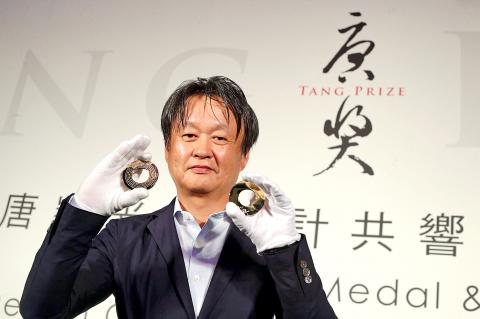Renowned Japanese industrial designer Naoto Fukasawa took the US$500,000 top prize yesterday in a competition to design medals for winners of the Tang Prize (唐獎) — an international award established by Taiwanese entrepreneur Samuel Yin (尹衍樑) for global leaders in the fields of sustainable development, biopharmaceutical science, Sinology and the rule of law. The prizes have a total fund of NT$3 billion (US$ 1 million).
The winner of the International Invitational Tang Prize Medal Design Competition was announced in Taipei at an award ceremony attended by the 10 of the finalists, all of whom are prominent names in international design.
The nine other finalists receive US$50,000 each.

Photo: CNA
Fukasawa, a designer for Japanese retailer Muji and many other international brands, has been named as one of the world’s most influential designers by Bloomberg Businessweek magazine and has won several other prestigious awards, including the US’ International Design Excellence Award and Germany’s iF design award.
He is known for his simple and intuitive industrial designs. He believes a good design should blend naturally with a user’s behavior, without the user having to think about it, a design philosophy he has named “Without Thought.”
One of his most famous pieces is a wall-mounted CD player he designed for Muji in the 1990s, which became one of Japan’s most iconic industrial designs of that time.
His winning designs for the Tang Prize feature medals in the shape of spiral curves. Descriptions of the four categories of the Tang Prize — are carved into the back of each medal in circles along the spiral structure.
The other finalists were Kenji Ekuan from Japan, GK Design Group chairman and former International Council of Societies of Industrial Design president Gunter Wermekes, a German goldsmith and designer who designed the new Red Dot Trophy; Australian graphic designer Harry Williamson; and Kan Tai-keung (靳埭強), dubbed Hong Kong’s “father of graphic design.”
The other finalists were Taiwanese designer Chen Jun-liang (陳俊良), known for his use of Chinese calligraphy and Eastern imagery; Dutch graphic designer Irma Boom, who specializes in book design; Italian jewelry designer Massimo Zucchi; British graphic and coin designer Matthew Dent; and British jewelry artist Lin Cheung, who designed the medals for the London 2012 Paralympics.
The Tang Prize Foundation and Taiwan Design Center jointly organized the International Invitational Tang Prize Medal Design Competition, inviting 25 international design organizations to nominate designers.
A total of 61 designers from 15 countries were nominated.
Ten designers were selected by an international panel of judges in February to participate in the final round.
For the finals, each designer presented a medal design for each of the four categories of the Tang Prize. The winning medals will be manufactured by the Central Mint from pure gold and will have a diameter of 6.6cm.
The Tang Prize was established to honor top international researchers in the four categories.
The first laureates will be announced on June 18. Up to three winners will claim a cash prize of NT$50 million for each category.

An essay competition jointly organized by a local writing society and a publisher affiliated with the Chinese Communist Party (CCP) might have contravened the Act Governing Relations Between the People of the Taiwan Area and the Mainland Area (臺灣地區與大陸地區人民關係條例), the Mainland Affairs Council (MAC) said on Thursday. “In this case, the partner organization is clearly an agency under the CCP’s Fujian Provincial Committee,” MAC Deputy Minister and spokesperson Liang Wen-chieh (梁文傑) said at a news briefing in Taipei. “It also involves bringing Taiwanese students to China with all-expenses-paid arrangements to attend award ceremonies and camps,” Liang said. Those two “characteristics” are typically sufficient

A magnitude 5.9 earthquake that struck about 33km off the coast of Hualien City was the "main shock" in a series of quakes in the area, with aftershocks expected over the next three days, the Central Weather Administration (CWA) said yesterday. Prior to the magnitude 5.9 quake shaking most of Taiwan at 6:53pm yesterday, six other earthquakes stronger than a magnitude of 4, starting with a magnitude 5.5 quake at 6:09pm, occurred in the area. CWA Seismological Center Director Wu Chien-fu (吳健富) confirmed that the quakes were all part of the same series and that the magnitude 5.5 temblor was

The brilliant blue waters, thick foliage and bucolic atmosphere on this seemingly idyllic archipelago deep in the Pacific Ocean belie the key role it now plays in a titanic geopolitical struggle. Palau is again on the front line as China, and the US and its allies prepare their forces in an intensifying contest for control over the Asia-Pacific region. The democratic nation of just 17,000 people hosts US-controlled airstrips and soon-to-be-completed radar installations that the US military describes as “critical” to monitoring vast swathes of water and airspace. It is also a key piece of the second island chain, a string of

The Central Weather Administration has issued a heat alert for southeastern Taiwan, warning of temperatures as high as 36°C today, while alerting some coastal areas of strong winds later in the day. Kaohsiung’s Neimen District (內門) and Pingtung County’s Neipu Township (內埔) are under an orange heat alert, which warns of temperatures as high as 36°C for three consecutive days, the CWA said, citing southwest winds. The heat would also extend to Tainan’s Nansi (楠西) and Yujing (玉井) districts, as well as Pingtung’s Gaoshu (高樹), Yanpu (鹽埔) and Majia (瑪家) townships, it said, forecasting highs of up to 36°C in those areas